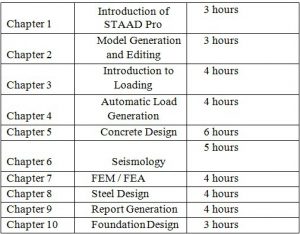STAAD's full form is Structural Analysis and Design. STAAD Pro is one of the popular software that is used for analyzing & designing structures like – buildings, towers, bridges, industrial, transportation, and utility structures. Designs may include any building structures like tunnels, culverts, bridges, piles, and petrochemical plants; and building materials like timber, concrete, steel, cold-formed steel, and aluminum. STAAD or STAAD.Pro was developed by Research Engineers International at Yorba Linda, CA in 1997. To get rid of the boring & time-consuming manual procedures architectural Engineers started using automated software STAAD.Pro
What is STAAD Pro:
STAAD.Pro
® is one of the most widely-used software for developing and analyzing the designs of various structures, such as petrochemical plants, tunnels, bridges, etc. STAAD.Pro
® v8i, the latest version, allows
civil engineering individuals to analyze structural designs in terms of factors like force, load, displacements, etc. Multisoft Virtual Academy STAAD.Pro
® v8i online training builds expertise in using the software at a professional level in domains, including construction companies, government agencies, architecture firms, etc. Participants are equipped with various software functionalities like model generation and editing; loading analysis; concrete designing etc. The STAAD.Pro
® v8i software training also offers proficiency in using seismology; report generation; and steel and foundation design features. After completing the
STAAD.Pro® v8i training, individuals can work as Structure Designers, Project Managers, Building Analysts, Quality Analysts, Bridge, Designers, etc.
About STAAD Pro Software Capabilities:
- Analyze for time-dependent effects
- Check designs for cold-formed sections
- Comply with seismic requirements
- Create finite element meshes
- Design & analyze with finite element meshes, structural models
- Design beams, columns, walls, and resisting frames
- Design to international design standards
- Loads and load combinations
- Integrate slab and foundation designs
- Model reinforced concrete, steel
- Structural design documentation
- Share structural models
Why learn?
STAAD.Pro provides a flexible modeling environment, fluent data collaboration, and advanced features. It best structural analysis & design software that supports Indian as well as all international codes. STAAD.Pro permits structural engineers to design & analyze any type of structure virtually. Structural consultants, structural engineering firms, departments in construction companies, government agencies, owner/operators, offshore platform designers, and many more are extensively using this software.
Learning Objectives:
The course will cover all the steps involved in structural analysis & designing of concrete & steel. This course will introduce one to STAAD Pro’s state-of-the-art user interface, prevailing analysis and design engines with sophisticated finite element (FEM), visualization tools, and dynamic analysis capabilities. Some of the features that we focus on in training include:
Model Generation: Generation of an interactive menu-driven model with concurrent 3D display 2D & 3D graphics generation using rectangular or polar coordinate systems Segments of repetitive geometry used to generate complex structural models.
- Model Verification: 2D/3D drawings on-screen and printer/plotter full 3D shapes for frames, elements Isometric, or any rotations for full 3D viewing.
- Static Analysis: 2D/3D analysis on the basis of state-of-the-art Matrix method to handle extremely large Linear, non-linear, p-delta analysis with automatic load & stiffness correction.
- Dynamic/Seismic Analysis: Mass modeling, frequency, and mode shape Response spectrum extraction, analysis of time history Modal damping ratio for individual models.
- Secondary Analysis: Finite element capabilities, concrete design, steel design, and timber Forces & displacements at sections between nodes. Maximum & minimum force envelopes.
Learning Outcome:
- Students will be able to complete object-oriented instinctive 2D/3D graphic model
- Students will learn to use pull-down menus, tool-tip help, and floating
- Students will be able for carrying out flexible zooms and multiple
- Students will know to make isometric & perspective views and 3D
- Students will know the use of simple command language and a built-in command file editor.
- Students will learn how to generate graphics/text
- Students will be able to do efficient algorithms that will minimize disk space
- Students will learn to take presentation-quality printer plots of geometry and results as part of the run output.
- Students will be able to perform accurate and numerically efficient plate/shell element incorporating out-of-plane shear & in-plane rotation; automatic element mesh generation; comprehensive element stress output including in-plane stresses, out-of-plane shear, bending & principal stresses at nodal, as well as, user-specified points.
- Students will learn how to achieve user-specified design parameters to customize a
- Students will know to perform code check, member selection, and optimized member selection consisting of analysis/design
- Students will be able to design concrete beams/columns/slabs/footings as per all major
Course Contents:
- Introduction to STAAD Pro® V8i
- Model Generation and Editing
- Introduction to Loading
- Automatic Load Generation
- Concrete Design
- Seismology
- FEM / FEA
- Steel Design
- Report Generation
- Foundation Design
Target Audience
Content Structure:
 Also Read: Civil Engineering with Specialization in Construction Planning and Management at DIT University Dehradun
Also Read: Civil Engineering with Specialization in Construction Planning and Management at DIT University Dehradun